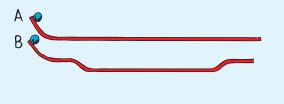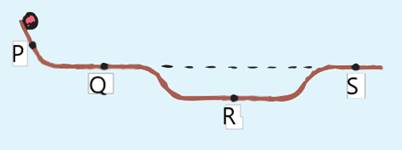
Concept explainers
Refer to the tracks in the previous problem.
a. Does the ball on B roll faster in the dip than the ball rolling along track A?
b. On track B, is the speed gained going down into the dip equal to the speed lost going up the dip? If so, do the balls then have the same speed at the ends of both tracks?
c. Is the average speed of the ball on the lower part of track B greater than the average speed of the ball on A during the same time?
d. So overall, which ball has the greater average speed? (Do you wish to change your answer to the previous exercise?)
(a)
To identify: Whether ball on B roll faster in the dip or the ball on track A.
Answer to Problem 50A
Yes, ball B roll faster in the dip than the ball on track A.
Explanation of Solution
Introduction: Assuming there is no friction on the tracks. When the ball is moving on the downfall curve then speed increases due to gravitational force. When it moves its upward curve then speed decreases as the ball has to do work against gravitational force.
As shown in the figure below:

On track A, only 1 downward curve is present. So, the ball will gain speed and then moves in constant speed on the straight line.
On track B, there are 2 downfalls and one upward curve. So, the ball will gain speed with the first one and then after moving for a while in a straight line will again gain speed on the second downfall.
Conclusion: Thus, Ball on track B will roll faster than the ball on track A.
(b)
Speed of balls at the ends of both tracks.
Answer to Problem 50A
Both balls have the same speed at the end of their respective track.
Explanation of Solution
Introduction: Average speed is calculated as the total distance traveled on the tracks divided by the time taken.
On track A, the ball accelerates on a single dip and then moves with a constant speed.
On track B, there are 2 dips and one up. So, the ball will gain speed with the first one and then after moving for a while in a straight line will again gain speed on the second downfall. Due to the upward curve, it will work against gravity. Thus, its speed will decrease and ends up with a similar speed as the ball has at the end of track A.
B track can be illustrated as shown in the figure below:

P: slower, but accelerating
Q: faster and constant speed
R: Firstly, accelerates and moves with constant speed then decelerates
S: fastest speed equivalent to segment Q
The average speed of the ball will have a faster speed as on segment Q.
Conclusion:
Both balls have the same speed at the end of their respective tracks.
(c)
To check: The average speed of the ball on the lower part of track B is greater or the ball on track A during the same time.
Answer to Problem 50A
Yes, the average speed of the ball on the lower part of track B is greater than the ball on track A during the same time.
Explanation of Solution
Introduction:
Average speed is calculated as the total distance traveled on the tracks divided by the time taken.
As explained above for the sub-section b, it is clear that the ball on track B has 2 dips that accelerate the ball twice and hence, increases its speed.
Conclusion:
Thus, the average speed of the ball on the lower part of track B is greater than the ball on track A during the same time.
(d)
The ball with the greater average speed overall.
To check: Changes need to be made in the previous exercise.
Answer to Problem 50A
Ball on track B has a greater average speed overall. No changes need to be done in the previous exercise.
Explanation of Solution
Introduction: Average speed is calculated as the total distance traveled on the tracks divided by the time taken.
As explained above for the sub-section b, it is clear that the ball will accelerate twice and gain speed as compared to the single dip acceleration gained by the ball on track A.
Since balls gain speed on their track differently but end up with the same speed during the same time on the complete track. But, no ball on track B has greater average speed overall, when compared with the other ball on track A.
Conclusion: Ball on track B has a greater average speed overall. No changes need to be done in the previous exercise.
Chapter 4 Solutions
CONCEPTUAL PHYSICS-W/PRACTICING PHYSICS
Additional Science Textbook Solutions
Chemistry: Structure and Properties (2nd Edition)
Introductory Chemistry (6th Edition)
Brock Biology of Microorganisms (15th Edition)
Campbell Essential Biology (7th Edition)
Biology: Life on Earth (11th Edition)
Microbiology: An Introduction
- answer both questionsarrow_forward- 13- 3. Shastri recalled reading that for an ideal transformer, "the ratio of the primary voltage to the secondary voltage is equal to the ratio of the secondary current to the primary current." Plan and design an experiment to investigate whether the statement above is true. (8) • With the aid of a fully labelled circuit diagram, describe a procedure which can be used to investigate whether the statement is true. The circuit diagram must include the following components: A variable AC voltage supply • AC voltmeters • AC ammeters A transformer with adjustable turns ratio Connecting wires • ° A load resistorarrow_forwardanswer question 1-6arrow_forward
- Fractions 1. Covert 5/7 to a decimal 2. 5/7 x 3/8 3. 2/5 divided 4/9 4. covert 37/ 19 to a decimalarrow_forwardthis is an exam past paper question that i need help with becuase i am reviewing not a graded assignmentarrow_forwardsunny (1) -13- end. One box contains nothing inside; one has a piece of resistance wire between the terminals You are provided with three sealed identical matchboxes labelled A, B and C, with terminals at each and the other, a semi-conductor diode. Plan and design an experiment to identify the contents of each box. You are provided with the following elements for your apparatus: Ammeter Low voltage power supply Connecting wires Labelled circuit diagram Draw a well-labelled circuit diagram to show how you would connect the apparatus listed above to each matchbox. (3 maarrow_forward
- RAD127 Radiographic Equipment and Computers SI Units in Radiography Ch. 1 & 2 Instructions: Provide the units for each of the following in full and short forms 1. Mass - kg, 9 or (1b)) ・ 2. Energy, Work - W = FD,J 3. Air kerma -(Gya) 4. Absorbed Dose- 5. Effective Dose J/kg (94+) jlkg J/kg, Sv 6. Radioactivity - 5-1, Bq 7. Weight 8. Time 9. Force 10. Power B9 wt, wt-mg, N -(s) F= ma, N, OR 1b. (JIS), P= work It = Fdlt, Jarrow_forwardanswer 1-8arrow_forward1 . Solve the equation 2/7=y/3 for y. 2. Solve the equation x/9=2/6 for x. 3. Solve the equation z + 4 = 10 This is algebra and the equation is fraction.arrow_forward
- two satellites are in circular orbits around the Earth. Satellite A is at an altitude equal to the Earth's radius, while satellite B is at an altitude equal to twice the Earth's radius. What is the ratio of their periods, Tb/Taarrow_forwardFresnel lens: You would like to design a 25 mm diameter blazed Fresnel zone plate with a first-order power of +1.5 diopters. What is the lithography requirement (resolution required) for making this lens that is designed for 550 nm? Express your answer in units of μm to one decimal point. Fresnel lens: What would the power of the first diffracted order of this lens be at wavelength of 400 nm? Express your answer in diopters to one decimal point. Eye: A person with myopic eyes has a far point of 15 cm. What power contact lenses does she need to correct her version to a standard far point at infinity? Give your answer in diopter to one decimal point.arrow_forwardParaxial design of a field flattener. Imagine your optical system has Petzal curvature of the field with radius p. In Module 1 of Course 1, a homework problem asked you to derive the paraxial focus shift along the axis when a slab of glass was inserted in a converging cone of rays. Find or re-derive that result, then use it to calculate the paraxial radius of curvature of a field flattener of refractive index n that will correct the observed Petzval. Assume that the side of the flattener facing the image plane is plano. What is the required radius of the plano-convex field flattener? (p written as rho )arrow_forward
 College PhysicsPhysicsISBN:9781305952300Author:Raymond A. Serway, Chris VuillePublisher:Cengage Learning
College PhysicsPhysicsISBN:9781305952300Author:Raymond A. Serway, Chris VuillePublisher:Cengage Learning University Physics (14th Edition)PhysicsISBN:9780133969290Author:Hugh D. Young, Roger A. FreedmanPublisher:PEARSON
University Physics (14th Edition)PhysicsISBN:9780133969290Author:Hugh D. Young, Roger A. FreedmanPublisher:PEARSON Introduction To Quantum MechanicsPhysicsISBN:9781107189638Author:Griffiths, David J., Schroeter, Darrell F.Publisher:Cambridge University Press
Introduction To Quantum MechanicsPhysicsISBN:9781107189638Author:Griffiths, David J., Schroeter, Darrell F.Publisher:Cambridge University Press Physics for Scientists and EngineersPhysicsISBN:9781337553278Author:Raymond A. Serway, John W. JewettPublisher:Cengage Learning
Physics for Scientists and EngineersPhysicsISBN:9781337553278Author:Raymond A. Serway, John W. JewettPublisher:Cengage Learning Lecture- Tutorials for Introductory AstronomyPhysicsISBN:9780321820464Author:Edward E. Prather, Tim P. Slater, Jeff P. Adams, Gina BrissendenPublisher:Addison-Wesley
Lecture- Tutorials for Introductory AstronomyPhysicsISBN:9780321820464Author:Edward E. Prather, Tim P. Slater, Jeff P. Adams, Gina BrissendenPublisher:Addison-Wesley College Physics: A Strategic Approach (4th Editio...PhysicsISBN:9780134609034Author:Randall D. Knight (Professor Emeritus), Brian Jones, Stuart FieldPublisher:PEARSON
College Physics: A Strategic Approach (4th Editio...PhysicsISBN:9780134609034Author:Randall D. Knight (Professor Emeritus), Brian Jones, Stuart FieldPublisher:PEARSON





